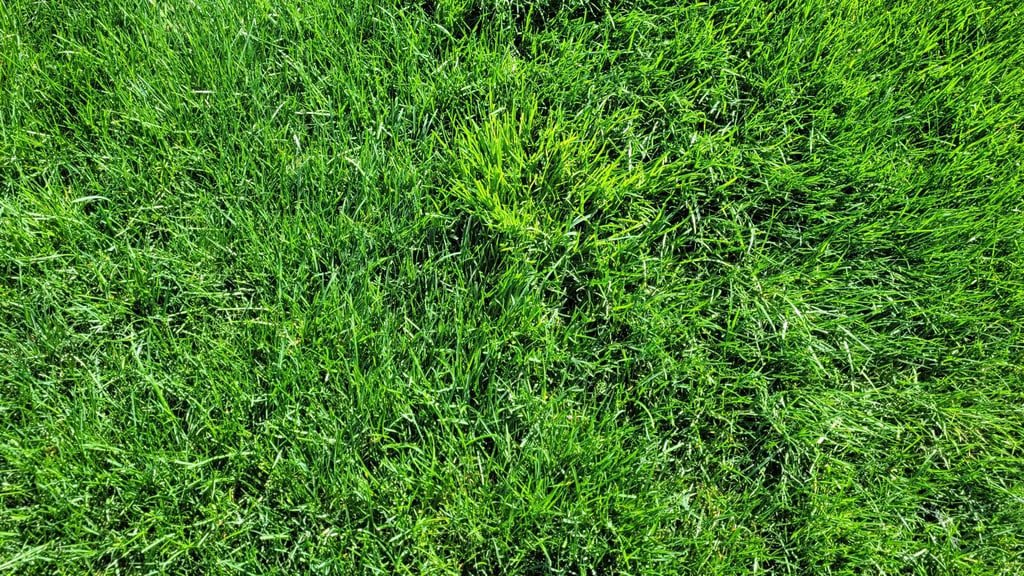&@$#...you got the Triv! Now what?


&@$#...you got the Triv! Now what?
If you're reading this, I hate to break it to you. You have Poa Trivialis and you know it.
No, it's not new grass.
No, you didn't miss a spot with the fertilizer.
No, it's not crabgrass, orchard grass or Poa Annua.
If you think you have it, you have it.
Poa Trivialis is pretty noticeable. It will be a lighter shade of green. It grows at a faster rate so it will stick out a few days after a mow. It has a waxy type feel to the blades. It pulls up easily due to it not having a root structure.
You'll know it when you see it. But the telltale sign that you have Poa Trivialis and not another type of grass or noxious weed is by bending back one of the blades and looking at where the blade meets the stem. This will reveal what is called a ligule, or a thin membrane or scale that is on the inner side of the blade and the junction of the stalk.
When you bend it back, if you see a small, white triangle that looks like onion skin, its Poa Trivialis:
Yeah, you searched through thelawnforum, YouTube and all the Facebook groups looking for a cure. Now let's get this next part out of the way.
"I heard if I apply Tenacity three times in a row..." Stop. Doesn't work.
"But if you mix Speedzone with a growth regulator and apply it twice over a period of..."NO!
"The Russian's developed an experimental herbicide that targets Poa Triv back in the 70's that is only available by importing it through a company in the Ukraine..." Stop this nonsense, everyone knows you can only import it through Kazakhstan.
Let's be clear. The only known cures for Poa Trivialis in a cool season lawn are as follows:
Velocity: an herbicide that has been discontinued for several years.
Poa Cure: an herbicide only available to those in the professional golf maintenance field.
Xonerate: labeled to "control" Poa Trivialis but actual results are very low and not worth the time or investment (ask me how I know).
There is currently no herbicide available to the homeowner to prevent or eliminate Poa Trivialis.
Where does it come from?
There are many theories as to how your lawn became infected. They could all be correct. Poa Trivialis seed is sold at many seed retailers. Cross contamination at the seed production and packaging facility is a possibility. Poa Trivialis seed is very small, and often looks like Kentucky Bluegrass seed.
It also could lie dormant in your lawn for years, waiting to sprout when conditions are right. Here's an article about 142 year old seeds being dug up for an ongoing experiment that are still germinating: https://www.npr.org/2021/04/21/989333092/the-secret-mission-to-unearth-part-of-a-142-year-old-experiment.
It's possible that animals carried the seed to your yard. Or your aeration helped it to spread.
But you just did a lawn renovation you say? Remember, Poa Trivialis goes dormant in hot weather. If you killed your lawn when it was still hot out, you probably missed it seeing how it was not active.
Really, at this point it doesn't matter how you got it, just that it's there.
How do I kill it?
So the answer to killing your Poa Trivialis is using a non-selective herbicide, like Round-Up, that contains glyphosate.
Even then glyphosate is not 100% effective. If you choose to spot spray with glyphosate, you should use multiple applications to any spots that you apply the grass killer to. You should also kill a wide enough perimeter around the problem area. But even then you may not have killed it all and it's important to follow up with cultural practices to discourage Poa Trivialis growth. Mow high. Don't water too much. Avoid shade.
However, you can tip the odds in your favor.
Use glyphosate, Round-Up, and spot spray the sections generously at least twice while the Poa Trivialis is active. Poa Triv is most active in cool season lawns during the spring.
Then, once the grass is dead, remove all the debris and dig up the section, replacing it with new soil. You can also use sod for immediate results. Seed or use plugs to regrow each area.
If it's a small outbreak, instead of using a hand pump sprayer, if you want more control try a sponge or paint brush dipped in the glyphosate mix.
Ridding your lawn of Poa Trivialis could be a never ending process. You could have missed some during your last renovation. Maybe you didn't get it all when you were eradicating it spot by spot. Even some old seed can spring to life. It's just a common problem for those that care about their lawn.
Just do your best to kill what you can see and contain it.
Is this the end of my lawn?
We are over-sensitive perfectionists when it comes to grass. I've spent hours researching and hundreds of dollars trying to find a cure. Guess what?
It always came back.
I have Poa Trivialis and it's ok. Say it with me.
My lawn still looks great. 99.9% of the population has no idea what we're even talking about, they just like the "cool looking stripes".
Control it to the best of your ability. Use cultural practices to keep it in check. Know that everybody has it. And your lawn still looks fantastic.
After all, if it was easy having a great looking lawn, everybody would have one.
Turf & Stem
© 2025 TURF & STEM, ALL RIGHTS RESERVED | POLICIES | TERMS OF SERVICE
TurfAndStem@Gmail.com
